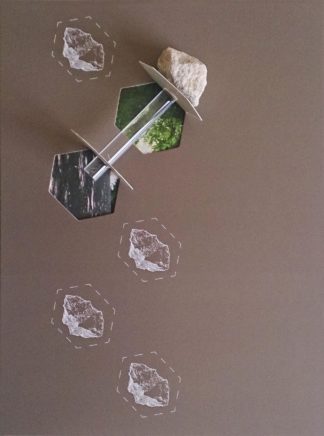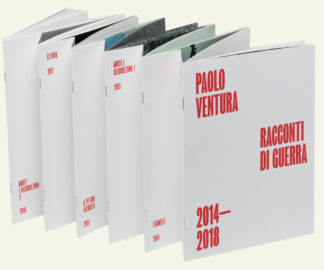Descrizione
Paolo Simonazzi si è espresso ed è conosciuto per una ricerca legata all’idea della serialità: ha usato la sua lente fotografica per esplorare e indagare, nel corso del tempo, un soggetto, un tema, declinandolo in situazioni e contesti differenti.
La mostra So near, so far presentata alla Collezione Maramotti nel 2016 in occasione di Fotografia Europea, ha proposto un altro approccio al suo lavoro, che travalica l’idea di serie e la “coerente uniformità” dell’oggetto di indagine. Un taglio che ha tentato di mettere a fuoco lungo il suo percorso fotografico, il suo sguardo sulla nostra terra, intesa come crocevia di comunicazioni semantiche, culturali, linguistiche, visuali attraverso una scelta di scatti che coprono vent’anni del suo lavoro (dalla metà degli anni Novanta al 2014).
Nel nostro territorio è presente un’osmosi molto peculiare con il resto del mondo: oggetti, parole, modi di stare insieme denotano una tensione verso l’alterità che al contempo viene ri-visitata, re-inventata mantenendo un sapore genuinamente “nostrano”.
Tutto ci appare mosso dalla consapevolezza e dalla voglia di riconoscersi in un mondo ormai globalizzato, ma senza rinunciare a quella ritualità sociale, a quello speciale rapporto con tempo e spazio che ci riporta e ci connette a solide radici locali.
Le immagini di Simonazzi raccontano di come l’altro, l’estraneo si sposa con il domestico, col quotidiano della provincia, spesso di sapore rurale, sicuramente provinciale nella accezione più genuina del termine; non descrivono posture kitsch, ma fanno sorridere per la loro intrinseca, ingenua naturalezza.
Le sue fotografie transitano da visioni più rarefatte e quasi sospese – in cui il tempo diviene spazio nel paesaggio e negli oggetti – a immagini che parlano di relazioni quotidiane in un territorio confidente, con sguardo complice e al contempo ironico.
Una mostra che si è voluto presentare come un piccolo viaggio emozionale dentro la nostra terra, in cui la strada – la Via Emilia appunto che la attraversa e che costituisce una vera e propria musa in questo progetto – diventa anche stilema espositivo. Le foto sono state timorosamente appuntate in orizzontale, su un supporto che ricorda il selciato. Il visitatore è invitato a percorrerlo e a riconoscersi, come avviene durante una passeggiata a piedi, in bicicletta o in auto nelle nostre campagne.
(Marina Dacci)

The photos of Paolo Simonazzi on view in this exhibition bring into sharp focus and illustrate the subject matter and themes that are clearly dear to him and characterize his style. Drawn from several different series of work, these images derive their power and meaning from the quotidian as well as the shared consciousness and experiences of the viewer. To engage with these images is to journey between real, remembered, and imagined places and states of mind.
Simonazzi clearly recognizes the complex role and power of the photographic image to redefine and reframe notions of time, memory, and the process of looking. He essentially offers new interpretations into what it means to look and see. Luigi Ghirri, an acknowledged and visible influence, offered this possibility that Simonazzi reconsiders. Simonazzi draws out a great connection with the essence and spirit of place that is La Via Emilia. He then injects and fuses this spirit with a foreign element that is straight from his own soul: his love for the romance of the American road culture. The interesting key of the photos in the exhibition is Simonazzi’s ability to capture our imagination by weaving together two traditions and their emblems: the deep, rich history of the Via Emilia, and the mythology of the American road.
For Simonazzi, the road is a muse. The artist’s straightforward deadpan, ironic portrayal of the subject matter, is the hallmark of the visual vocabulary that is the history and tradition of American road photography. From Walker Evans and Robert Frank to Ed Ruscha and Stephen Shore, to the recent voices in the ballad of the highway, the vision of the open road was how photographers embraced the subject of America in order to reflect on place, time, memory, and self. A gas station, a billboard along side of the road, a diner shut down for the day, are all the iconic images captured by the American photographers who established this visual tradition of neglected beauty.
The work of William Eggleston also informs Simonazzi’s choice of subject matter. The contents of a bedroom, the bric-a-brac of tools and photos hanging on a wall with no seeming relationship to one another, all equally democratized and given equal visual weight, reveal Simonazzi’s debt to Eggleston’s icons of banality.
So many examples in this exhibition demonstrate how Simonazzi adopts the cultural iconography and poetic yet ironic vision of these American photographers, and combines the vision with the formal structuring of the composition he learned from Ghirri. Simonazzi composes his subjects squarely, usually in the fore or middle ground of the photo, not allowing the eye to wander from the center. The subject is treated as a still life, although the arrangements of the objects can often seem to be jumbled and chaotic. Simonazzi does not get in the way of his subjects, but rather allows them to penetrate into and speak directly to us as we engage head-on with the narrative. The power of his photos lies in their directness and ability to illuminate the easily overlooked, by elevating the mundane to the extraordinary and the quirky to the humorous.
Simonazzi understands and uses light to elevate this otherwise ordinary subject matter. Where as, Ghirri freezes his cool, and sometimes detached images in time, Simonazzi’s light is different and his images derive their power and efficacy with vigor and immediacy to engage the viewer as the story unfolds through time.
In this way, Simonazzi establishes his own visual narrative style. The compositions sometime employ a slightly warmer, even light that unifies and communicates his feelings for the subject matter, creating a sense of nostalgia. These photographs can be seen as small self–portraits of the artist as well as intimate portraits of the people and land of his upbringing. His, is a thoughtful and considered approach to the subject matter and composition that is guided by meaning and significance.
Simonazzi’s images strike a chord with all, no matter the nationality, and evoke memories of time and place that are universally shared. The transformative power of the images is in part the key to their success. Meaning and dignity derive from the ordinariness of his subjects, elevating mundane objects, rooms and possessions of simple people, to the iconic.
The everyday subject matter in the larger story that is La Via Emilia is captured in his elegy to the road and its people. In this, Simonazzi is influenced by the writings of Guareschi, who so loved the simple people of this region. However, his vision also seems elsewhere, in a place he has been seduced to, a different road that is both near and far. The result is a collective visual diary of images that bridge nationalities and cultures. The photos create an intimate love song that resonates with all who live on the road, regardless of time or country.
“There’s nothing that the road cannot heal” – Connor Oberst
(Gina Costa)





